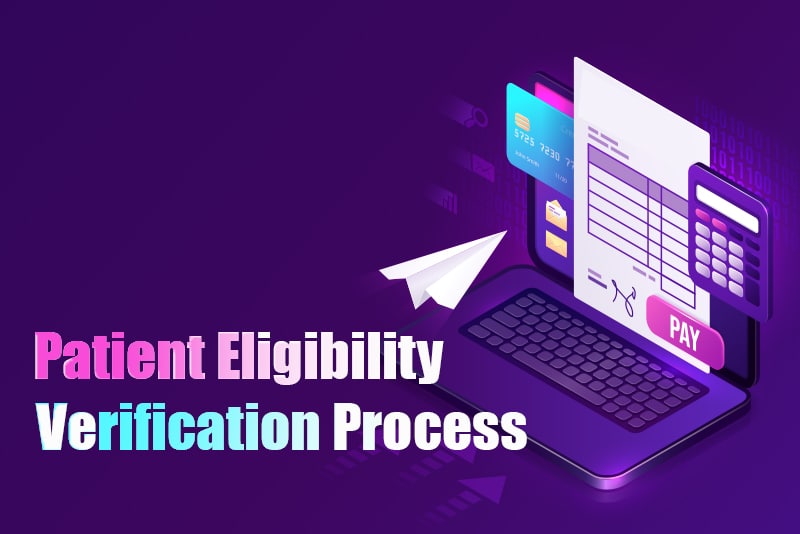Running a healthcare practice is just like running any other kind of business. As physicians provide patient-centered care for a wide variety of conditions, they also need to pay attention to their bottom line. Proper medical billing practices, including patient eligibility verification, are essential to get paid. Patient eligibility and benefits verification involves confirming the coverage patients have by checking information such as coverage, copayments, and deductibles and more. Verification of patient benefits can help avoid claim rejections for reasons associated with eligibility, increase cash flow, and improve the patient experience.
Health insurance eligibility verification is one of the first steps in the medical billing process.
Patient Eligibility Verification Process
The standard process involves the following:
- Patient scheduling and enrollment – Registering the patient involves gathering their intake materials. Each patient’s demographic and insurance details are collected to identify the patient, maintain their medical history, and verify insurance eligibility.
- Eligibility verification – The patient’s active coverage is verified with the insurance company.
- Authorization – This involves obtaining approval from the insurance company for a medical procedure or service.
- Informing the patient – The patient is informed about the outcome of the verification process.
- Updating the medical billing system – The practice billing system is updated with insurance verification and eligibility details.
Doing it right the first time can help you get paid correctly and without delay. Here are top ways to improve the efficiency of the patient eligibility verification process:
- Start when scheduling appointments: Ask for and record the patient’s current health insurance information before scheduling an appointment for the treatment/service. Insurance information and other required data for eligibility verification can be discussed on the phone with the patient. This preliminary real-time eligibility check will help you determine if any gaps exist and inform the patient about it. You can also remind patients of co-pay collection policies and about obtaining a referral if their plan requires it.
- Double check the information during pre-registration: Insurance plans can change within just a few days. So if the appointment was scheduled months in advance, it makes sense to recheck the patient’s coverage details 3-4 days before the day of the appointment. This is also important to fill in any missing data or make corrections on information that may have been incorrectly entered in the registration systems at scheduling. Validate all the details before they are entered. Patients can complete the pre-registration forms at home, where they can easily refer to their medical histories.
- Check eligibility at registration if the plan requires it: Check patient insurance information at every visit. Some Health Plans such as Medicaid and Managed Medicaid plans require verifying eligibility on the day of the appointment. In such cases, verify insurance coverage real-time during registration.
- Post-appointment eligibility verification: In some cases, it may be necessary to verify eligibility after a visit, such as when online eligibility in unavailable, to confirm that issues found during registration have been resolved, etc. If a claim is denied, re-verification would be needed to provide evidence that the patient had coverage at the time of service.
- Determine pre-authorization needs: Health insurance companies require certain medical services and medications that physicians prescribe to be evaluated to determine medical necessity before they are authorized. Insurance verification involves checking a health plan’s policy rules or formulary to see if a prior authorization is required for a particular treatment or service. If it is required, you need to submit a prior authorization request without delay and obtain the approval. This is important to provide timely care and to reduce denial risk.
- Record the verified information: The information that has been verified should be recorded in the practice’s medical billing system. Maintain the data along with supporting evidence such as a photograph of the patient’s insurance ID. In addition to recording patient information, insurance verification and authorization specialists will also record the date and time they called the payer, visited their website, and so on.
- Evaluate patient’s knowledge about insurance-related aspects and educate them: Insurance is complex and hard to understand. A layperson would have limited or no knowledge about insurance terms. Rules are constantly changing and patients may change plans each year. Best practice is to prepare a cheat sheet of basic insurance terms and explain to them how their insurance works. By taking the time to educate your patients, you can eliminate any confusion they may have about their coverage to help them get the care they need and avoid surprise bills.
- Prepare a price estimate for the patient: After verifying the patient’s benefits, calculate the patient responsibility and insurance payment. Share with them how much they might need to pay out of pocket and what their plan will possibly cover. Accurate cost estimates can improve price transparency and enhance patient satisfaction.
- Remind patients about their financial responsibility at check-in: Upfront communication can benefit both the patient and the physician. Create a clear-cut financial policy and post it on your practice website. When patients call to schedule or re-schedule appointment, gently remind them about their responsibility to pay deductibles and past due amounts. They should be informed about payment expectations at the time of service. Try to collect remaining deductible balance at checkout.
- Track the frequency and reasons for eligibility related denials: If a claim is rejected or denied due to incorrect patient information, the inconsistency should be resolved and the claim should be resubmitted. The database should be updated with the registration information to prevent the same problem from recurring. Tracking denial patterns and reasons and taking steps to resolve them is critical to improve eligibility verification processes
Outsourcing patient eligibility verification to an expert can help practices adhere to these best practices. Leading insurance verification companies have experienced teams who are knowledgeable about the requirements of different insurance plans. They will ensure that the process is correctly completed well ahead of the patient appointment and thereafter as needed. Their services can save your practice the time and resources that would go into managing the complex eligibility verification process in-house.




